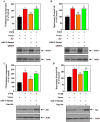TGFβ-stimulated microRNA-21 utilizes PTEN to orchestrate AKT/mTORC1 signaling for mesangial cell hypertrophy and matrix expansion
- PMID: 22879939
- PMCID: PMC3411779
- DOI: 10.1371/journal.pone.0042316
TGFβ-stimulated microRNA-21 utilizes PTEN to orchestrate AKT/mTORC1 signaling for mesangial cell hypertrophy and matrix expansion
Abstract
Transforming growth factor-β (TGFβ) promotes glomerular hypertrophy and matrix expansion, leading to glomerulosclerosis. MicroRNAs are well suited to promote fibrosis because they can repress gene expression, which negatively regulate the fibrotic process. Recent cellular and animal studies have revealed enhanced expression of microRNA, miR-21, in renal cells in response to TGFβ. Specific miR-21 targets downstream of TGFβ receptor activation that control cell hypertrophy and matrix protein expression have not been studied. Using 3'UTR-driven luciferase reporter, we identified the tumor suppressor protein PTEN as a target of TGFβ-stimulated miR-21 in glomerular mesangial cells. Expression of miR-21 Sponge, which quenches endogenous miR-21 levels, reversed TGFβ-induced suppression of PTEN. Additionally, miR-21 Sponge inhibited TGFβ-stimulated phosphorylation of Akt kinase, resulting in attenuation of phosphorylation of its substrate GSK3β. Tuberin and PRAS40, two other Akt substrates, and endogenous inhibitors of mTORC1, regulate mesangial cell hypertrophy. Neutralization of endogenous miR-21 abrogated TGFβ-stimulated phosphorylation of tuberin and PRAS40, leading to inhibition of phosphorylation of S6 kinase, mTOR and 4EBP-1. Moreover, downregulation of miR-21 significantly suppressed TGFβ-induced protein synthesis and hypertrophy, which were reversed by siRNA-targeted inhibition of PTEN expression. Similarly, expression of constitutively active Akt kinase reversed the miR-21 Sponge-mediated inhibition of TGFβ-induced protein synthesis and hypertrophy. Furthermore, expression of constitutively active mTORC1 prevented the miR-21 Sponge-induced suppression of mesangial cell protein synthesis and hypertrophy by TGFβ. Finally, we show that miR-21 Sponge inhibited TGFβ-stimulated fibronectin and collagen expression. Suppression of PTEN expression and expression of both constitutively active Akt kinase and mTORC1 independently reversed this miR-21-mediated inhibition of TGFβ-induced fibronectin and collagen expression. Our results uncover an essential role of TGFβ-induced expression of miR-21, which targets PTEN to initiate a non-canonical signaling circuit involving Akt/mTORC1 axis for mesangial cell hypertrophy and matrix protein synthesis.
Conflict of interest statement
Figures









Similar articles
-
High glucose enhances microRNA-26a to activate mTORC1 for mesangial cell hypertrophy and matrix protein expression.Cell Signal. 2015 Jul;27(7):1276-85. doi: 10.1016/j.cellsig.2015.03.007. Epub 2015 Mar 20. Cell Signal. 2015. PMID: 25797045 Free PMC article.
-
Reciprocal regulation of miR-214 and PTEN by high glucose regulates renal glomerular mesangial and proximal tubular epithelial cell hypertrophy and matrix expansion.Am J Physiol Cell Physiol. 2017 Oct 1;313(4):C430-C447. doi: 10.1152/ajpcell.00081.2017. Epub 2017 Jul 12. Am J Physiol Cell Physiol. 2017. PMID: 28701356 Free PMC article.
-
TGFβ acts through PDGFRβ to activate mTORC1 via the Akt/PRAS40 axis and causes glomerular mesangial cell hypertrophy and matrix protein expression.J Biol Chem. 2020 Oct 16;295(42):14262-14278. doi: 10.1074/jbc.RA120.014994. Epub 2020 Jul 30. J Biol Chem. 2020. PMID: 32732288 Free PMC article.
-
Targeting the translational apparatus to improve leukemia therapy: roles of the PI3K/PTEN/Akt/mTOR pathway.Leukemia. 2011 Jul;25(7):1064-79. doi: 10.1038/leu.2011.46. Epub 2011 Mar 25. Leukemia. 2011. PMID: 21436840 Review.
-
GSK3 and its interactions with the PI3K/AKT/mTOR signalling network.Adv Biol Regul. 2017 Aug;65:5-15. doi: 10.1016/j.jbior.2017.06.003. Epub 2017 Jun 27. Adv Biol Regul. 2017. PMID: 28712664 Review.
Cited by
-
Insights into the Therapeutic uses of Plant Derive Phytocompounds onDiabetic Nephropathy.Curr Diabetes Rev. 2024;20(9):e230124225973. doi: 10.2174/0115733998273395231117114600. Curr Diabetes Rev. 2024. PMID: 38265383 Review.
-
Akt2 causes TGFβ-induced deptor downregulation facilitating mTOR to drive podocyte hypertrophy and matrix protein expression.PLoS One. 2018 Nov 16;13(11):e0207285. doi: 10.1371/journal.pone.0207285. eCollection 2018. PLoS One. 2018. PMID: 30444896 Free PMC article.
-
Anti-Cancer Effects of Dietary Polyphenols via ROS-Mediated Pathway with Their Modulation of MicroRNAs.Molecules. 2022 Jun 14;27(12):3816. doi: 10.3390/molecules27123816. Molecules. 2022. PMID: 35744941 Free PMC article. Review.
-
Signaling Cross Talk between TGF-β/Smad and Other Signaling Pathways.Cold Spring Harb Perspect Biol. 2017 Jan 3;9(1):a022137. doi: 10.1101/cshperspect.a022137. Cold Spring Harb Perspect Biol. 2017. PMID: 27836834 Free PMC article. Review.
-
Circulating TGF-β1-Regulated miRNAs and the Risk of Rapid Progression to ESRD in Type 1 Diabetes.Diabetes. 2015 Sep;64(9):3285-93. doi: 10.2337/db15-0116. Epub 2015 Apr 30. Diabetes. 2015. PMID: 25931475 Free PMC article.
References
-
- Schnaper HW, Hayashida T, Hubchak SC, Poncelet AC (2003) TGF-beta signal transduction and mesangial cell fibrogenesis. Am J Physiol Renal Physiol 284: F243–252. - PubMed
-
- Eddy AA, Neilson EG (2006) Chronic kidney disease progression. J Am Soc Nephrol 17: 2964–2966. - PubMed
-
- Bottinger EP (2007) TGF-beta in renal injury and disease. Semin Nephrol 27: 309–320. - PubMed
-
- Iwano M, Kubo A, Nishino T, Sato H, Nishioka H, et al. (1996) Quantification of glomerular TGF-beta 1 mRNA in patients with diabetes mellitus. Kidney Int 49: 1120–1126. - PubMed
-
- Kopp JB, Factor VM, Mozes M, Nagy P, Sanderson N, et al. (1996) Transgenic mice with increased plasma levels of TGF-beta 1 develop progressive renal disease. Lab Invest 74: 991–1003. - PubMed
Publication types
MeSH terms
Substances
Grants and funding
LinkOut - more resources
Full Text Sources
Molecular Biology Databases
Research Materials
Miscellaneous

